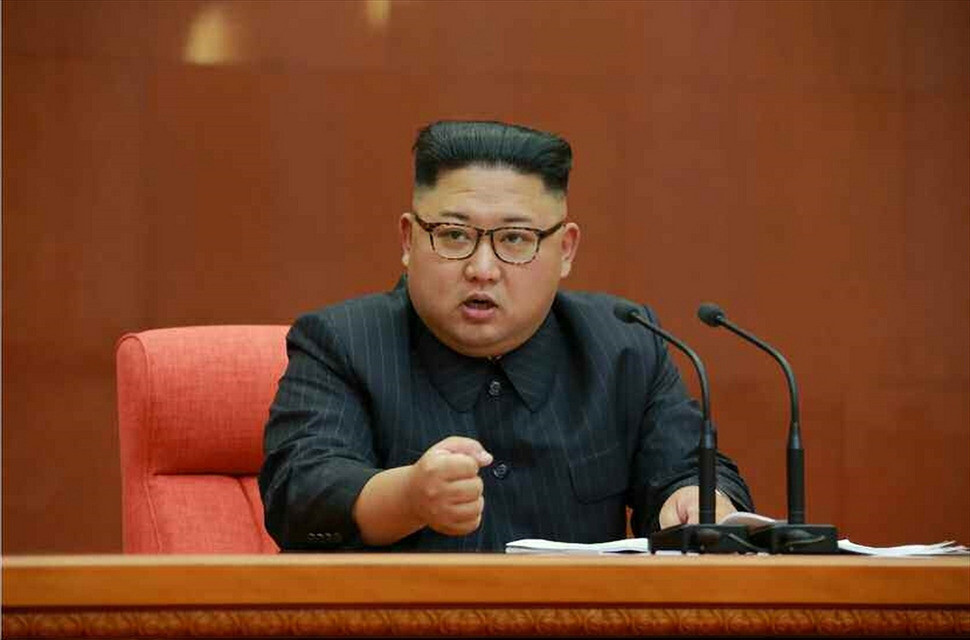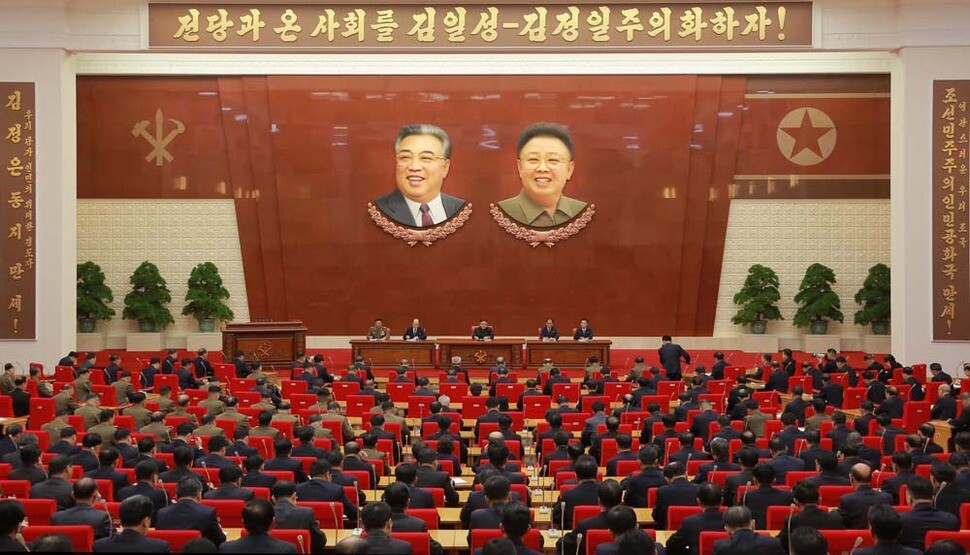hankyoreh
Links to other country sites 다른 나라 사이트 링크
Kim Jong-un announces switch to economic development

“Let us focus our energies on building a socialist economy!”
This was the new “party strategy” presented by North Korean leader Kim Jong-un after declaring an end to the “two-track course” of economic and nuclear development at a third plenary session of the seventh Workers’ Party of Korea (WPK) Central Committee.
Kim’s description alone does not provide enough to gauge the specifics, direction, or intensity of the new approach. But the “targets” announced by the Kim at the meeting showed no signs of hyperbole. They are frank in their assessment of the reality. Kim explained that the “current goals of the struggle” are to achieve “normalization of all factory and company production” and achieve an “abundant autumn in every field” over the period of the five-year national economic development strategy (2016–2020) so that the “sounds of the people’s joyful laughter ring out far and wide.”

In the medium and long terms, he called for “providing all the people with an abundant and developed life with nothing to envy.” The details suggest the leaders were unable to conceal the difficult realities for the North Korean economy since the 2013 adoption of the two-track course, with the strengthening of the North’s nuclear armament and increased sanctions from the UN and international community in response. The use of the phrase “normalization of production” is an example. The implication is that with upcoming inter-Korean and North Korea-US summits, Kim hopes to use denuclearization as leverage to obtain a loosening of international sanctions and economic support and cooperation.
Kim also set out guidelines calling for “unconditional obedience of the Cabinet’s integrated directions to see the party’s economic policy through.” It was a statement of commitment to cracking down on the “politicization of economic policy” through party and military involvement, which outside experts have pointed to as a longstanding problem for the North Korean economy.
Assessing the details, direction, and intensity of Kim’s “new strategy” requires a look back at his speech during the seventh WPK Congress in May 2016. In that speech, Kim declared that “building a powerful economy” was the “basic front where the party and countries must channel all its energies at the present time,” before going on to summarize the “Kim Jong-eun model of economic reform and openness” policies he had attempted since taking power in 2012. These policies amounted to a “five-year strategy” as an intermediate-term economic plan, promoting “economic development zones” with his economic openness strategy model, and formalizing a “North Korean approach to economic management” as a strategy to achieve the “Kim Jong-un model of economic reform” – namely development of a market economy.
The five-year strategy’s importance lies in its being the Kim Jong-un era’s first strategy approach for economic policy. Over 20 economic development zones have been established to date following orders by Kim at a WPK Central Committee plenary session on Mar. 31, 2013. Eight of them are operating in the Chinese border region, include the Yalu (Amnok) and Tumen (Duman) River areas.
Economic development zones are a key means of achieving the “Kim Jong-un model of external economic openness,” which involves decentralization to the North Korea-China border region and other localities. Often referred to as the “May 30 measures,” the “North Korean approach to economic management” is known in the North as the “socialist corporate responsibility management system” – key elements of which include legalizing various currently illegal or semi-legal market-related activities and boosting autonomy and incentives for factories, farms, and other economic actors. Outside experts have focused on this as the “Kim Jong-un model of marketization,” or an early measure in Kim’s model of economic reform.
While the “three-item set” in Kim’s model of economic reform and openness failed to gain traction amid intensifying international sanctions in response to the North’s nuclear program, Kyungnam University Institute for Far Eastern Studies professor Lim Eul-chul described Kim as “opening the door to the market at the same time as he prepared for war.” The message is that the situation could change completely after the inter-Korean and North Korea-US summits, depending on how much sanctions can be lifted in response to progress with denuclearization.
While some have suggested Kim is attempting to follow that Deng Xiaoping did in spearheading reforms and openness in China, it is still too early to reach any conclusions. In logical terms at least, Kim drew a clear line with full-scale reforms and openness, stressing that the “basic principle of the new revolutionary course” would be “regeneration through our own efforts.”
By Lee Je-hun, senior staff writer and Kim Ji-eun, staff reporter
Please direct questions or comments to [english@hani.co.kr]

Editorial・opinion
![[Column] Season 2 of special prosecutor probe may be coming to Korea soon [Column] Season 2 of special prosecutor probe may be coming to Korea soon](https://flexible.img.hani.co.kr/flexible/normal/500/300/imgdb/original/2024/0426/3317141030699447.jpg) [Column] Season 2 of special prosecutor probe may be coming to Korea soon
[Column] Season 2 of special prosecutor probe may be coming to Korea soon![[Column] Park Geun-hye déjà vu in Yoon Suk-yeol [Column] Park Geun-hye déjà vu in Yoon Suk-yeol](https://flexible.img.hani.co.kr/flexible/normal/500/300/imgdb/original/2024/0424/651713945113788.jpg) [Column] Park Geun-hye déjà vu in Yoon Suk-yeol
[Column] Park Geun-hye déjà vu in Yoon Suk-yeol- [Editorial] New weight of N. Korea’s nuclear threats makes dialogue all the more urgent
- [Guest essay] The real reason Korea’s new right wants to dub Rhee a founding father
- [Column] ‘Choson’: Is it time we start referring to N. Korea in its own terms?
- [Editorial] Japan’s rewriting of history with Korea has gone too far
- [Column] The president’s questionable capacity for dialogue
- [Column] Are chaebol firms just pizza pies for families to divvy up as they please?
- [Column] Has Korea, too, crossed the Rubicon on China?
- [Correspondent’s column] In Japan’s alliance with US, echoes of its past alliances with UK
Most viewed articles
- 1After election rout, Yoon’s left with 3 choices for dealing with the opposition
- 2Why Kim Jong-un is scrapping the term ‘Day of the Sun’ and toning down fanfare for predecessors
- 3Two factors that’ll decide if Korea’s economy keeps on its upward trend
- 4Noting shared ‘values,’ Korea hints at passport-free travel with Japan
- 5AI is catching up with humans at a ‘shocking’ rate
- 6Why Korea shouldn’t welcome Japan’s newly beefed up defense cooperation with US
- 7‘We must say no’: Seoul defense chief on Korean, USFK involvement in hypothetical Taiwan crisis
- 8[Column] Season 2 of special prosecutor probe may be coming to Korea soon
- 9Korea’s 1.3% growth in Q1 signals ‘textbook’ return to growth, says government
- 10Exchange rate, oil prices, inflation: Can Korea overcome an economic triple whammy?